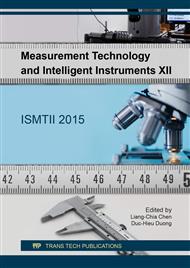p.418
p.427
p.432
p.439
p.447
p.453
p.459
p.465
p.470
Investigation of the Effect of Ultrasound on Cell Growth
Abstract:
Several studies have been made on cell growth by the ultrasound irradiation. It is important to change the output, irradiation time and duty cycle for cell growth. The duty cycle determined the proportion of the time that the ultrasound was “on”. We can control cell growth by changing these three terms. The purpose of this study is to find the optimum conditions for cell growth and examine a new factor to influence cell growth. Cell concentration was determined by measuring the absorbance with a spectrophotometer. In this study, the absorbance became highest on 10min ultrasound irradiation and the duty cycle of 67% in experimental conditions. However, when 30 min ultrasound irradiation and the duty cycles of 86%, the absorbance became close to the highest value too. The results suggested that, in addition to the duty cycle, the off time of ultrasound might also affect the cell growth.
Info:
Periodical:
Pages:
447-452
Citation:
Online since:
September 2017
Authors:
Keywords:
Price:
Сopyright:
© 2017 Trans Tech Publications Ltd. All Rights Reserved
Share:
Citation:


